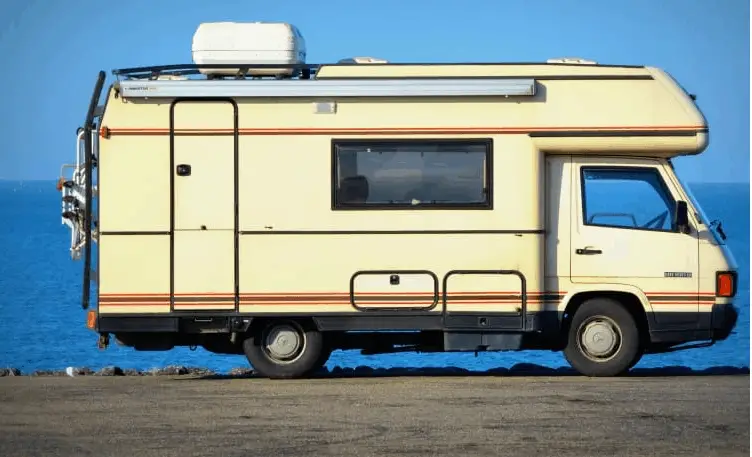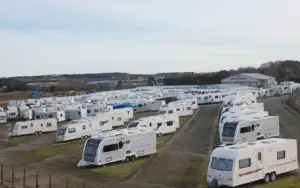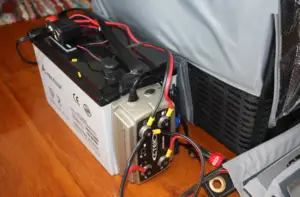It is incredibly important to have a stable and sturdy roof as it is an essential part of the RV. Therefore, knowing your RV and understanding how to maintain it is paramount. There are different types of roofing materials used on an RV such as rubber, fiberglass, and aluminum.
First, you should know the type of roof your RV has so that you can determine the kind of maintenance it will need.
Rubber is the most common material used for an RV roof. Fiberglass adds both cost and weight to the RV but is low on maintenance as compared to the rubber ones.
You will rarely find aluminum on RV roofs. Like fiberglass, aluminum also adds weight to the RV and is low on maintenance. Regular cleaning of your RV roof will not only prolong its life but also keep your RV looking new. So, let’s see how to protect RV roofs.
Maintaining rubber RV roofs
Rubber, due to its lightweight and durability, is widely used for RV roofs. But it can be easily damaged by certain chemicals and does not last forever.
Rubber roofs come in two different types – EPDM( Ethylene Propylene Diene M-Class rubber) and TPO ( thermoplastic polyolefin). Both types require slightly different maintenance.
EPDM can get easily oxidized and leave gray and white streaks on the sides of the RV. EPDM also becomes exceptionally slippery when wet. On the other hand, TPO roofs do not get oxidized, show no signs of gray or white streaks, and do not become slippery when wet. TPOs are less porous as compared to EPDM roofs and do not absorb dirt and mold quickly.
Regardless, of the type you have, regular cleaning and maintenance is required to avoid serious repairs. RV roofs need to be cleaned at least four times in a year if not parked in a covered location.
Any product that uses petroleum distillates, citrus based cleaners or harsh abrasives can cause the EPDM rubber to swell and loosen. Read the roof warranty documentation and use the right cleaning supplies, or you may void your warranty.
Cleaning RV Rubber roof
If you have to clean your rubber RV roof, the first step is to sweep off any dirt, grime from the roof, giving special attention to areas around any fixtures on the roof.
You can rinse off as much grime as possible from the roof and sides using a hose, a mild cleaner, and a medium bristle brush. If your travel trailer or RV roof is filthy, cover the sides of the vehicle with some plastic sheets to save you the clean-up later.
It is recommended to apply a water-repellent rubber roof treatment or a protectant to the roof with a sponge mop to seal it. A protectant can increase the life of the roof and reduce the need to repair the roofing material. But use the protectant in the shade or early morning, as high temperatures can quickly dry the treatment.
Check the caulking or lap sealants for any cracks or wear. Apply the sealant around air conditioner openings, vents, screw heads, skylights, and under the trim strips.
Allow the sealant to dry properly. Rubber roofs are more vulnerable to chalking and can cause streaking on the sidewalls of your RV.
To get rid of the chalking, you can use rubber roof treatment or specialized roof cleaners with water and a medium bristle brush. But if the chalking recurs within a month or two, you can repeat the cleaning process, and this time treat the rubber surface with a good quality protectant.
Repeat this process every six months. Small repairs can be done by applying butyl rubber repair and sealing tape to all affected areas. One very important tip is to always park your RV in an area where the roof is as much protected as possible.
Maintaining fiberglass RV roofs
Fiberglass roofs need more maintenance and need the same cleaners used on an automobile or a boat. They also need to be waxed regularly to prevent oxidation. They also need to be waxed so that anything that comes into contact slides right off. If you are waxing your fiberglass roof yourself, make sure to use one with a UV protectant.
When waxing the roof yourself, work in small areas and be careful as the waxed roof can be a lot slicker than a wet roof.
Fiberglass roofs are sturdy and do not bend like metal roofs. If you have a fiberglass roof, it is vital to ensure that any old sealer that has become loose is taken off and replaced with a new one.
Maintaining aluminum RV roofs
Aluminum roofs will also require periodic gentle cleaning with specialized cleaners. It is essential to inspect the roof regularly and repair any cracked or opened sealing. Both fiberglass and aluminum roofs are easy to maintain but are expensive and cumbersome.
How often to seal RV roof
Different types of sealant can be used in RV’s. Initially, when the manufacturer builds the roof it can be strong. But, over time it may loose it strength due to sunlight or UV exposure. Air pollution, wind, and other elements also deteriorate the roof.
Thus, it’s necessary to reseal the roof from time to time. Ideally one should seal the roof every six to eight months. Or at least check should be performed to make sure the roof is in good condition.
Try to identify cracks, gaps, and fill those with proper sealant. It is important to check for signs like voids, peelings. Another thing to make sure is to use the same sealant that was originally used. It is therefore necessary to know your RV roof in-and-out.
Remember any negligence on RV roof can result in physical damage and water can leak inside. Such damages may also not be under warranty.
How often should the RV roof be cleaned?
Cleaning your RV roof depends upon where you park it and where you travel in it. But still, your RV needs a periodic cleaning at least 3 to 4 times every year. Regular inspection of your RV roof is essential.
You should be able to see the surface of the RV roof. If you are not able to see the surface of your roof due to dirt or grime, it is time to clean it.
Parking your RV under trees that drop leaves and sap will make frequent cleaning indispensable. Also, if you travel more to moist and warm areas, chances of your RV roof getting mold will spike, making it essential to clean it more often.
Taking care of your RV roof can save you some expensive water damages also. Roof quality may vary depending on the type of RV. A less costly travel trailer or pop up camper may not have great quality roof. A class A RV or class C motorhome on the other hand can have better roof. Thus, its always better to follow manufacturer recommendations when cleaning RV roof.
Can you pressure wash RV roof?
If you have a rubber RV roof, it is not a good idea to pressure wash it. Pressure washing rubber RV roof can be tough on your RV’s exterior, cause damage to the paint, and the worn-out seals and caulking.
Some products used for cleaning rubber RV roofs recommend high-pressure wash, but you should not set the pressure too high.
High pressure can be detrimental to your RV walls and the roof. Pressure wash makes removing tough dirt, and bird droppings a lot easier but can result in leaks and other issues in your RV.
Your RV roof, whether made of rubber or any other type will also have other things on its roof, such as vents and air-conditioners mounted with screws. High-pressure wash can wreck the mounting.
Small cracks or gaps can become big holes. Therefore do not pressure wash your RV roof on high. Use a pressure-adjustable nozzle and set the pressure to 1000 psi or even less.
Can you use bleach on the RV rubber roof?
Bleach is deemed effective at killing molds on the RV roof. When mold forms on the rubber roof, remove it quickly to stop it from causing long-term damage to the RV roof.
Rubber is porous, and the mold can penetrate the surface of the rubber, and over time, causes the rubber to fall apart. Bleach can kill the mold faster but can also be damaging, resulting in discoloration and weakening of the rubber.
Is it right to cover the RV roof?
Roof covers can protect your RV, especially if you store it under trees or in a highly dusty area, or outdoors during winters. A roof cover is an excellent way of keeping dirt, grime, debris, snow, sap, and even sun off your RV roof when not in use. Buy a good quality RV roof cover that is sturdy, waterproof, and allows moisture to escape.
Avoid using a traditional blue polyethylene tarp to cover your RV for an extended period, as tarps do not allow any air to flow around the RV and can lead to mold issues in your awnings and slideouts, even in a short amount of time.
These tarps can also be abrasive to your RV. They are not designed to fit an RV. So invest in an appropriate covering for your RV and say no to the blue tarps.
Can you walk on the RV roof?
Whether you can walk on your RV roof or not will depend upon the make and model of your RV and the kind of structural support the roof offers. You would go up on your RV’s roof occasionally for fixing your air conditioner or for installing a tv antenna or for cleaning. Therefore it becomes crucial to know if your RV roof will hold without any issues.
An RV roof should be able to hold the weight of one person comfortably. So, a load of approximately 300 lbs should be bearable.
Nevertheless, you should avoid going on the roof of your RV frequently as it is not suitable for the life of its roof. You can do some of these activities without going up on the roof.
You can clean the roof by standing on the ladder and using a brush with a sufficient extension to reach everywhere on the roof. Many RVs come with built-in backside ladders and can be great for getting up there. If your RV does not have a ladder, you can add a portable frame ladder.
Avoid unnecessary roof walks and sitting. An old RV roof endures sunlight, snow, and its surface may not remain as good as that of a new RV. Moreover, materials like rubber also become soft and chalky over time, curtailing the capacity of your RV roof to hold heavy weights.
Conclusion
RV roof maintenance is critical. In most cases RV life depends much on its roof life. Replacing an RV roof can be hectic and a costly affair. Thus make sure, it is maintained and cleaned regularly. Make sure you do not exert weight on the roof and climb on it too often.





